Manuscript accepted on :
Published online on: 04-01-2016
Plagiarism Check: Yes
Premalatha Kanniyappan1, S. Kishore Kumar2, W. S. Manjula3
1Department of Orthodontics, Tagore Dental College & Hospital, Chennai 600 015 2Department of Orthodontics, Sree Balaji Dental College and Hospital, Bharath University, Pallikaranai, Chennai-600100 3Sree Balaji Dental College and Hospital, Bharath University, Pallikaranai, Chennai-600100
DOI : https://dx.doi.org/10.13005/bpj/760
Abstract
ABSTRACT: One of the most important events in the history of orthodontics was the introduction of direct Bonding.History dates back as early as 1950s when Buonocore introduced acid pretreatment of enamel using phosphoric acid and showed that this increses adhesion. These findings were further explored by George Newman who used it to bond direct attachments of orthodontic brackets and the rest as they say is history.
- Although numerous studies have been done about bonding there are very few studies which exclusively deal with enamel pretreatment or etching and its effect on bond strength as well as enamel.
- To cover all the topics under enamel etching namely,
- History
- Various etching methods and materials
- Enamel changes followed by etching ( SEM studies)
- Duration of etching
- New concepts in etching ( Laser etching,Self etchng primers,
- Changes in etching procedure while bonding to ceramic, porcelain etc
- Deletrious effects of etching (white spot lesions )
Keywords
Etching; Enamel pretreatment; Bonding; Acid pretreatment
Download this article as:| Copy the following to cite this article: Kanniyappan P, Kumar S. K, Manjula W. S. Enamel Pretreatment Before Bonding in Orthodontics- A Literature Review. Biomed Pharmacol J 2015;8(October Spl Edition) |
| Copy the following to cite this URL: Kanniyappan P, Kumar S. K, Manjula W. S. Enamel Pretreatment Before Bonding in Orthodontics- A Literature Review. Biomed Pharmacol J 2015;8(October Spl Edition). Available from: http://biomedpharmajournal.org/?p=3387> |
Introduction
History
One of the most important events in orthodontics appliance was the introduction of direct Bonding. This was the direct result of the pioneering work by Buonocore1 in the 1950’s . BUNOCORE introduced acid etching technique. He demonstrated increased adhesion produced by acid pretreatment of enamel USING 85% phosphoric acid for 30 seconds..This led to dramatic changes in practice of orthodontics
- In 1956 R.L. Bowen did the initial work on bis-GMA resin systems (Known as Bowen’s formula).
- Sadler (1958): Attempts to cement orthodontic attachments directly to enamel without etching have been recorded. Sadler tested nine materials (four dental cements, one rubber base cement, two metal adhesives and two general purpose adhesives) but these were all unsuccessful.
- Bowen (1962) developed a new resin system, Bisphenol-A-Glycidyl dimethacrylate commonly known as BIS-GMA and is often referred to as “Bowen’s Resin”.
- 1965-with the advent of epoxy resin bonding George Newman, one of Dr. Buonocore’s contemporaries developed similar methods to bond orthodontic brackets directly to the enamel of teeth (Newman. Snyder and Wilson, 1968) and began to apply these findings to direct bonding of orthodontic attachments
- Retief also described an epoxy resin system to withstand orthodontic forces.
- Smith in 1968 introduced zinc polyacrylate cement and bracket bonding with this cement.
- In 1971,Miura et al described an acrylic resin(orthomite), using a modified trialkyl borane catalyst that proved successful for bonding plastic brackets and in presence of moisture.In early 1970s considerable no, of preliminary reports were published on different commercially available direct &indirect bonding system.
A survey conducted by ZACHRISSON2 and LEONARD GOERLICK20 in 1979 JCO revealed almost 93% of orthodontists started bonding brackets (at least in anteriors )instead of banding
Advantages of Bonding
- Esthetically superior. Faster & Simpler.
- Less discomfort for the patient
- Arch length is not increased by band material.
- Allows more precise bracket placement even in tooth with aberrant shape.
- Improved gingival health.
- Better access for cleaning .
- Mesiodistal enamel reduction possible during treatment.
- Interproximal areas are accessible for composite buildup.
- Caries risk under loose bands is eliminated.Interproximal caries can be detected & treated.
- No band spaces to close at end of treatment.
- Brackets can be recycled further reducing the cost.
- Invisible lingual brackets can be used when esthetic is important.
- Attachments can be bonded to fixed bridgeworks.
Disadvantages
- Bonded brackets have weaker attachments than cemented band.
- If excess adhesive extends beyond bracket base increases risk of plaque accumulation
- Protection against interproximal caries of well contoured cemented brackets is absent.
- Bonding generally not indicated when lingual auxillaries or headgear required.
- Rebonding loose brackets require more preparation than rebanding loose bands.
- Debonding- more time consuming due to more difficult removal of adhesives.
- Evidence based decalcification& white spot lesion occurs more following bonding than banding
Basic Procedure in Etching
Bonding is based on the mechanical/chemical locking of an adhesive to irregularities in the enamel surface, and to mechanical locks formed in the base of orthodontic attachment.
Cleaning
- Thorough cleaning of teeth to remove plaque &organic pellicle that normally forms on teeth is mandatory.though authors 3, have questioned conventional pumice polishing
- Materials used are water slurry of pumice or prophylaxis paste with rotary instruments like rubber cup or small polishing brush.Reisner4 found more consistent results with the use of tungsten carbide bur at slow speed(25000 rpm) than with pumicing
Enamel Conditioning
Moisture control
Enamel pretreatment
After drying the tooth apply a conditioning solution or gel5 ( usually 37% to 50% phosphoric acid ) lightly over enamel surface with a pellet or brush for 15-60 sec.
Enchant is rinsed off with abundant water spray for about 15 sec. If salivary contamination occurs rinse with water spray & re etch for another 30 sec .
Dry the tooth thoroughly to obtain dull frosty white appearance. If not re etch
Cervical enamel because of its different morphology,might look different than incisal portion6.so they need not be re itched in order to produce uniform appearance.
Histology
Lehman & Davidson AJO 1981.When enamel is etched with phosphoric acid of high percentage like 50% it forms monocalcium phosphate monohydrate on the surface which is highly soluble in water & can be completely washed away leaving a roughness of larger surface area.There are 4 types of enamel appearance after various pre treatment
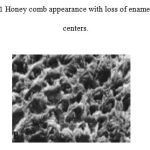 |
Figure 1: Honey comb appearance with loss of enamel prism centers. |
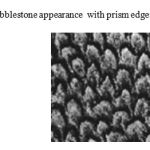 |
Figure 2 : Cobblestone appearance with prism edges lost. |
 |
Figure 3: Pitted enamel with maplike appearance. |
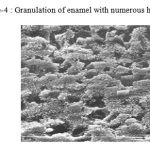 |
Figure 4: Granulation of enamel with numerous holes |
Duration of Etching
In AJO-DO 1980 Nordenwall7
Reported that 15 sec etching is adequate for young permanent teeth ,whereas 60 sec are needed for permanent teeth. Same author in 1981 that there is no significant differences appear between etching solution or gel. But gel provides better control for restricting the etched area but requires more thorough rinsing afterward.
Changes in Enamel After Etching8:
Microporosity within the enamel and
Reduces surface tension and allows the resin to penetrae and polymerize within the etched enamel rods.
Standard etchant dissolves about 5-10mm24 of enamel surface and creates a zone of etched enamel rods for about 15-25mm.
Etching process creates calcium monophosphate and calcium sulfate by-products that must be removed by a vigorous water rinse
Histological changes in Enamel After Etching 15,16
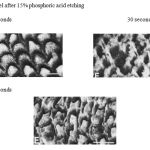 |
Figure 5 |
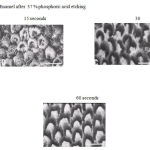 |
Figure 6 |
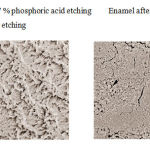 |
Figure 7 |
Air Abrasion
Its a older technique of enamel pretreatment introduced as early as 1940 by Dr. Robert black..It uses abrading with 50 um or 90 um particles of aluminium oxide for 3 sec at 10mm distance..AJO-DO 1997 Marc .E. Olsen9 et al reported that air abrasion significantly decreases bond strength & on debonding leaves no adhesive on enamel surface. So it is not recommended.
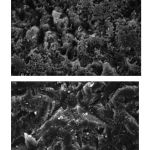 |
Figure 8 |
Crystal growth Theory10,11:
Jon Arton in AJO-DO 1984 reported crystal growth conditioning after use of polyacrylic acid with residual sulphate provided retention areas in enamel similar to phosphoric acid etching with less risk enamel damage at debonding
Phosphoric acid etched enamel surface Crystal growth on enamel surface
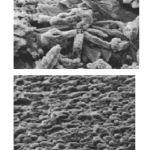 |
Figure 9 |
Effect of Fluoride
Though Zachrisson reports fluoride content of tooth has no effect on etching time.. Lehman& Davidson in AJO-DO 1981 reported that fluoride is important in decreasing enamel solubility17. Fluoridated enamel12 has highly acid resistant layer of 2-4 um thickness which may sometimes resist even 3 min etch. So avoiding fluoride application shortly prior to bonding is recommended.
Clinical and laboratory studies8 have shown that extra etching time is not necessary when teeth have been pretreated wuth fluoride.
Fluridated phosphoric acid solutions22, 23or gels provide an overall morphologic etching effect similar to non fluridated ones and give adequate bond strength in direct bonding procedures
Self Etching Primer
Bonding usually contains 4 steps.
- Cleaning
- Conditioning
- Primer application.
- Adhesive application prior to bracket placement.
Use of self etching primers13,14,18combines the conditioning & priming into single step
It contains methacrylated phosphoric acid ester formed when phosphoric acid& methacrylate groups are combined into a molecule that etches & primes simultaneously.
Phosphoric etched enamel surface : More dissolution & finely roughened surface
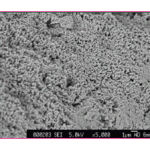 |
Figure 10 |
Self etching primed surface; Less disolution & enamel surface almost flat & presence of minutes holes
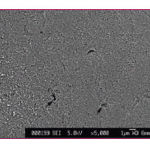 |
Figure 11 |
Advantages
- Decreases chair time
- Decreases technique sensitivity.
Bishara 19reported that there are more adhesive remaining on tooth surface after debonding when self etching primer is used than with conventional etching
Disadvantages
- It has significantly less bond strength when compared conventional etching & priming 2 step procedure. Supported by Aljibouri et al EJO 2003
- Bishara in AJO-DO 2002 also concluded that SEP produces less bond strength with are without saliva contamination
- His study showed that
- SEP Without saliva contamination – 6 Mpa
- Contamination before primer – 4.8 Mpa
- Contamination after primer – 4.8 Mpa
- Contamination before & after primer – 1.7 MPa
Rielco yamada et al in ANGLE 2002 reported that composite resin with SEP has less bond strength than when used with conventional 2 step etching . But its comparable with that of RMGIC after polyacrylic acid
Ram Kumar Gandhi et al in AJO-DO 2001 reported SEP produce more bond strength with used light activated composite than with chemically cured resin.
IN ANGLE 2002 SEP produces less enamel dissolutions than phosphoric acid or polyacrylic acid . This might have led to decrease in bond strength.
IN AJO-DO 2003 Ryan .W. Arnold et al and showed no significant diff, in bond strength occurred between SEP & conventional etching..
Amount of Enamel Iost During Etching
- Zachrisson- Routine etching with 37% phosphoric acid removes 3-10 um of surface enamel.
- Gwinnett et al -50% Phosphoric acid removes 5 – 25 um of enamel.
- Fitzpatrick & way and by Silverstone reported that 30% phosphoric acid for 90 sec removes enamel with a mean of 9.9 um
- Leebrown & Way –37% phosphoric acid in 90 secs removes a mean of 3 u ( 0.2 +11.2 um)
- With the SEPs, the median enamel loss was significantly lower, at 0.27µ m the range was 0.03 to 0.74µm.
- Scanning microscopy revealed that self – etching primer produced less dissolution of enamel surface compared with phosphoric acid. Enamel loss (Hosein et al AJO 2004)
First Generation
- BUONOCORE (1956) – Demondtsrated the use of a Glycerophosphoric acid dimethacrylate – containing resin, would bond to acid etching dentine.
- BOWEN (1965), tried N – phenylglycine and glycidyl methacrylate .
- Bonding occured due to the interaction of this bifunctional resin with the calcium ions of hydroxyapatite.
- Drawback – Poor bond strength (1 to 3 MPa ).
- The first commercial system of this type – Cervident, SS White
Second Generation
- In the late 1970’s the second generation system were introduced.
- Incorporated halophosphorous esters of unfilled resins such as bisphenol – A glycidal methacrelate or bis – GMA, or hydroxyethyl methacrylate, or HEMA.
- Bonded to dentine through an ionic bond to calcium by chlorophosphate groups.
- Weak bond strength, but significant improvement over first generation.
- Scotch Bond (3M Dental ), Clearfil (Kuraray Co. Japan)
Third Generation
- The primer contains hydrophilic resin monomers which include hydroxyethyl trimellitate anhydride, or 4–META, and biphenyl dimethacrylate or BPDM.
- The primers contain a hydrophilic group that infiltrates smear layer, modifying it and promoting adhesion to dentin.
- The phosphate primer modifies the smear layer by softening and cures, forming a hard surface. Following, the unfilled resin adhesive is applied, attaching cured primer to the composite resin.
- Drawback – Bonding to smear layer – covered dentine was not very successful.
- Mirage bond, Scotch bond 2, Prisma Universal bond 2 and 3.
Fourth Generation
- The use of the total etch technique is one of the main characteristics of fourth generation bonding system, here complete removal of the smear layer is achieved.
- The Total etch technique permits the etching of enamel and dentine simultaneously using 40% phosphoric acid for 15 to 20 seconds. The surface must be left moist to avoid collagen collapse.
- The application of hydrophilic primer solution can infiltrate collagen network forming the hybrid layer. According to Nakabayashi (1982) the hybrid layer is defined as “the structure formed in dental hard tissues by demineralization of the surface and subsurface, followed by infiltration of monomer and subsequent polymerization.
- All bound -2 (BISCO), Scotch bond Multipurpose (3M).
Fifth Generation
- Consist of two different types of adhesive materials the so called “one bottle” systems and the self etching primer bonding system.
- ONE BOTTLE SYSTEMS combined the primer and adhesives into one solution to be applied after etching. Total etching was done with 35 – 37% phosphoric acid for 15 to 20 secs.
- SELF ETCHING PRIMER was developed by Watanabe and Nakabayashi. It is a aqueous solution of 20% phenyl – P in 30% HEMA.
- An acidic primer combines the etchant with the primer in one application, Contains both acid (Phenyl – p) and the primer ( HEMA and dimethacrylate).
- Clearfil liner bond V (Kuraray)
- Mega bond (Kuraray)
- Prompt – L – Pop ( 3M UniteK )
- First step (Reliance)
- Transbond Plus ( Unitek 3m )
- Ideal 1 (GAC )
- One up Bond F ( Tokuyama)
- Adv – The combination of etching and priming steps reduce the working time.
- Single bond (3M), One step (BISCO)
Sixth Generation
- Recently several bonding system were developed and these systems are characterised by the possibility to achieve the proper bond to enamel and dentine using only one solution. These should really be one – step bonding.
- Unfortunately, the first evaluations of these new system showed a sufficient bond to a conditioned dentin while the bond with enamel was less effective.This may be due to systems are composed of an acidic solution cannot be kept in place, must be refreshed continuously and have a pK that is not enough to properly etch enamel.
- Prompt – L – Pop (ESPE, Germany).
Seventh Generation
The trend in the latest generation of dental bonding systems is to reduce the number of components and clinical placement steps. The introduction of 1 Bond, a single – bottle adhesive system, is the latest to new generation materials that combines etchant, adhesive and desensitizer one component.
New Concepts in Etching
Laser Etching
The application of laser energy to an enamel surfaces causes localized melting and ablation.
Results primarily from the micro-explosion of entrapped water in the enamel,some melting of the hydroxyapatite crystals.This new concept was proposed in 1993.Angle by J.A.Von Fraunhofer. He showed at 3 watts for 12 sec laser etching produced acceptable bond strength though significantly less than conventional acid etching. He used Nd/ YAG as laser source .Serder Usumuz et al in AJO-DO 2002 used ErCr ; YSGG as the hydrokinetic laser system for acid etching & came to the same conclusion.
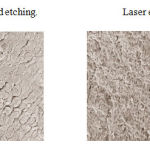 |
Figure 12 |
But major disadvantage as reported by Fraunhofer is that high laser produces heat in sufficient magnitude to cause at least localized pulpal infection & possible irreversible damage to pulpal tissue immediately opposite the site of laser irradiation.
Effect of Fluoride
Though Zachrisson reports fluoride content of tooth has no effect on etching time R. Lehman& Davidson in AJO-DO 1981 reported that fluoride is important in decreasing enamel solubility. Fluoridated enamel has highly acid resistant layer of 2-4 um thickness which may sometimes resist even 3 min etch. So avoiding fluoride application shortly prior to bonding is recommended.
But In AJO-DO Garcia Godey et al reported that addition of 0.5% NaF2 to 60% phosphoric acid gel produced significantly higher bond strength than 30% phosphoric acid without fluoride.
Bonding To Crowns & Restorations
Amalgam Restorations & Crowns
Methods used are
- Modifying metal surface
- Use of intermediate resin
- New adhesive resins that bond chemically to non-precious as well as precious metals
Recommended procedure By Zachrisson in ANGLE 98 & AJO-DO 2000
- Intra oral sandblasting amalgam alloy with 50 micron aluminium oxide for 3 sec as supported by Sperder In AJO-DO 1999
- . If small restorations, then condition the surrounding enamel with 37% phosphoric acid for 30 sec
- If large restoration or in crowns create a window & restore it with composite resin & continue the same process
- Apply reliance or any metal primer that has 4-META & wait for 30 sec
- Bond with concise resin
Bonding To Porcelin
Many in vitro studies has been conducted by Zachrisson & many others which gave controversial results in clinical practice.
Procedure
- Surface is to be roughened with sandpaper discs
- 8-9.6%HF acid gel applied for 2 min( HF is not effective when bonding to high alumina porcelins & glass ceramics)
- Silane coupling agent is optional.In vitro studies shows increased bond strength with silane addition.But clinically silane produce insignificant support to bond strength
Use concise resin for bonding
AJO-DO 1998 Zachrisson showed HF produce extensive in depth penetrating pattern .But diamond roughening & microetching produce only surface peeling.
AJO –DO 2004 Mutlu Ozean et al superior bond strength is obtained when ceramic surface is pretreated with silica coating & silanization giving about 13.6 MPa particularly with polycarbonate brackets
Iotrogenic Effect of Etching
- Fracture and cracking of enamel upon debonding .
- Increased surface porosity – possible staining
- Loss of acquired fluoride in outer 10 mm of enamel surface .
- Loss of enamel during etching .
- Resin tags retained in enamel – causing discoloration of resin.
- Rougher surface if over – etched.
References
- BuonocoreMG:A simple method of increasing the adhesion of acrylic filling materials to enamel surface,J Dental Res 34: 849,1955
- Zachrisson:a post treatment evaluation of direct bonding in orthodontics,Am J Orthod 71:173,1977
- Swartz ML: why prophy before bonding? Clinical impressions 3:11,1994
- ReisnerKR,levitt HL: Enamel preparation for orthodontic bonding:a comparision between use of sandblaster and current techniques, Am J orthod 111: 366,1997
- Brannstrom: Etching of young permanent teeth with acid gel, Am J Orthod 82: 379, 1982
- Arakawa : The effect of acid etching on cervical region of the buccal surface of the human premolar,with special reference to direct bonding techniques,Am J Orthod 76:201,1979
- Nordenvall KJ,Brannstrom: Etching of deciduous teeth and young and old permanent teeth: A comparision between 15 and 60 seconds of etching,Am J Orthod 78: 99,1980
- Nordenvall KJ,Brannstrom:Effect of various pretreatment methods of enamel in bonding procedures: Am J Orthod 74:134,1978
- Olsen ME,Bishara SE: Comparision of shear bond strength and surface structure between conventional acid etching and air abrasion of human enamel ,Am J Orthod 112: 502,1997
- Artun J Bergland S: clinical trials with crstal growth conditioning as an alternative to acid –etch pretreatment ,Am J Orthod 85: 333,1984
- Read MJF,Fergusan JW,Watts DC: Direct bonding :crystal growth as an alternative for acid etching?Eur J Orthod: 8:118,1986
- 12 Buyukiyalmaz T,Karaman :the effect of tensile bond strength of orthodontic brackets of titanium tetrafluride application after acid etching Am J Orthod108:256,1995
- Buyukiyalmaz T,Karaman :Effect of Self Etching primers on bond strength : Are they reliable?Angle Orthod 73:64-70,2003
- .Bishara SE,Oonsombat C,et al: Comparision of the shear bond strength of 2 self etch primer/adhesive systems Am J Orthod :125: 348-350,2004
- Gardner A, Hobson R. Variations in acid-etch patterns with different acids and etch times. Am J Orthod Dentofacial Orthop 2001;120:64-7.
- 26. Surmont P, Dermaut L, Martens L, Moors M. Comparison in shear bond strength of orthodontic brackets between five bonding systems related to different etching times: an in vitro study. Am J Orthod Dentofacial Orthop 1992;101:414-9.
- Benson PE, Shah AA, Millett DT, Dyer F, Parkin N, Vine RS.Fluorides, orthodontics and demineralization: a systematic review.J Orthod 2005;32:102-14.
- Velo S, Carano A, Carano A. Self-etching vs. traditional bonding systems in orthodontics: an in vitro study. Orthod Craniofac Res 2002;5:166-9.
- Bishara SE, VonWald L, Laffoon JF, Warren JJ. Effect of a self-etch primer/adhesive on the shear bond strength of orthodontic brackets. Am J Orthod Dentofacial Orthop 2001;119:621-4.
- Reynolds IR. A review of direct orthodontic bonding. Br J Orthod 1979;2:171-8.
- 4. Trites B, Foley TF, Banting D. Bond strength comparison of 2self-etching primers over a 3-month storage period. Am J Orthod Dentofacial Orthop 2004;126:709-16
- Garsia-Gordy F;HubbardGW,Storey AT: Effect of a fluoridated etching gel on enamel morphology and shear bond strength of orthodontic brackets,Am J Orthod 100;163,1991
- Meng CL,Wang WN,Yeh IS: Fluoridated etching on orthodontic bonding,Am J Orthod112: 259,1997
- Thompson IR,Way DC: Enamel loss due to prophylaxis and multiple bonding/debonding of orthodontic attachments,Am J Orthod 79:282,1981
- Osorio R, Toledano M, Garcia-Godoy F. Bracket bonding with15- or 60-second etching and adhesive remaining on enamel after debonding. Angle Orthod 1999;69:45-8.
- Shinchi MJ, Soma K, Nakabayashi N. The effect of phosphoricacid concentration on resin tag length and bond strength of a photo-cured resin to acid-etched enamel. Dent Mater 2000;16:324-9.
- Trites B, Foley TF, Banting D. Bond strength comparison of 2self-etching primers over a 3-month storage period. Am J Orthod Dentofacial Orthop 2004;126:709-16.
- Whitlock BO III, Eick JD, Ackerman RJ Jr, Glaros AG, ChappellRP. Shear strength of ceramic brackets bonded to porcelain.Am J Orthod Dentofacial Orthop 1994;106:358-64
- Mandall NA, Millett DT, Mattick CR, Hickman J, WorthingtonHV, Macfarlane TV. Orthodontic adhesives: a systematic review.J Orthod 2002;29:205-10.







